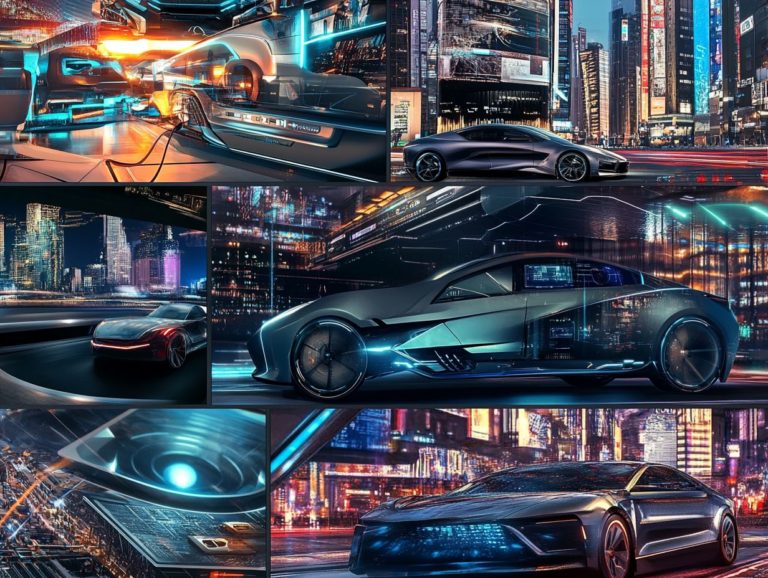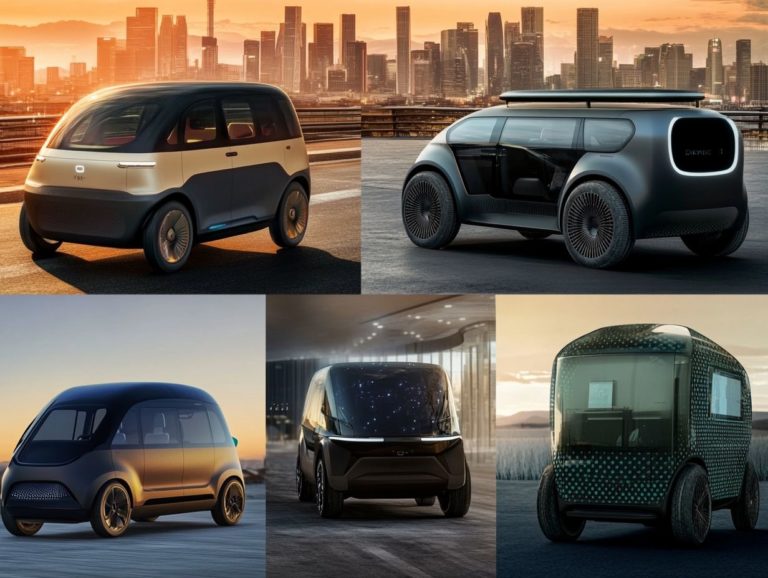How Legislation is Shaping the EV Market
The electric vehicle (EV) market is witnessing remarkable growth, driven by technological advancements and changing consumer preferences that you can t ignore.
With legislation taking center stage, government policies and regulations are shaping the landscape for automakers. This creates both opportunities and challenges. As they strive to meet new standards and innovate their offerings, the dynamics of the EV market evolve rapidly.
Let s dive into the exciting drivers of electric vehicle growth, the influence of legislation, and the future challenges and opportunities that await.
Uncover how this transformation is unfolding right before your eyes!
Contents
- Key Takeaways:
- The Growth of the EV Market
- Legislation Impacting the EV Market
- Government Policies and Incentives
- Regulations and Standards
- The Role of Automakers in the EV Market
- Efforts to Meet Legislative Requirements
- Challenges and Opportunities for the EV Market
- Frequently Asked Questions
- How is legislation impacting the growth of the EV market?
- What types of legislation are currently influencing the EV market?
- Why are governments implementing policies to promote EV adoption?
- How have tax credits impacted the EV market?
- What role do emission standards play in shaping the EV market?
- How does infrastructure funding affect the growth of the EV market?
Key Takeaways:

- Government policies and incentives are crucial for the growth of the electric vehicle market.
- Automakers invest in innovative technology and work to meet legislative requirements to stay competitive in the EV market.
- Despite challenges, the EV market has great potential for future growth and advancements.
The Growth of the EV Market
The electric vehicle (EV) market has experienced remarkable growth in recent years, propelled by rising concerns about climate change and the demand for cleaner energy.
Government policies, especially in states like California, have played a critical role by enforcing emissions regulations and offering incentives for electric vehicle adoption.
As we move further into the 21st century, the relationship between advancements in charging infrastructure and new battery technology opens up exciting opportunities for a sustainable future.
This evolution is set to reshape the transportation sector and reduce reliance on fossil fuels.
Factors Driving the Rise of Electric Vehicles
Several key factors are driving the rise of electric vehicles: escalating environmental concerns, breakthroughs in battery technology, and a surge in governmental support for clean energy initiatives.
As you become more aware of the environmental impact of traditional transportation, sustainability likely climbs higher on your list of priorities. A 2021 survey showed that nearly 60% of Americans are open to embracing electric vehicles, reflecting a significant shift in consumer mindset.
Technological advancements in battery components are enhancing EV efficiency and dramatically extending their range. Some models now travel over 300 miles on a single charge, making them an increasingly viable option for everyday use.
Climate change is influencing your purchasing decisions, urging you to opt for alternatives that could help mitigate global warming. Policymakers are actively championing a greener future, making the shift in public perception surrounding sustainable transportation more palpable than ever.
Legislation Impacting the EV Market
Legislation plays a vital role in shaping the electric vehicle market. Pivotal policies such as the Inflation Reduction Act and the Infrastructure Investment and Jobs Act facilitate greater EV adoption and infrastructure growth.
The Environmental Protection Agency has introduced emissions regulations that encourage automakers to embrace cleaner technologies. Tax incentives boost electric car sales and support the development of the charging infrastructure needed for a robust EV ecosystem.
This concerted effort ultimately paves the way for a sustainable future.
Time is running out, and your choices can make a real difference. Join the movement towards a sustainable future with electric vehicles!
Government Policies and Incentives

Government policies and incentives play a crucial role in accelerating your journey toward electric vehicle adoption. They offer you financial benefits and regulatory support, whether you’re a manufacturer or a consumer.
In states like California, these initiatives are carefully designed to align with ambitious climate goals. This ensures that your transition to electric vehicles is actively facilitated. Take the California Clean Vehicle Rebate Project, for example. It offers substantial rebates for qualifying electric vehicles, making them more accessible to you and many others.
Other forward-thinking states have also introduced similar tax credits and rebates. These create a welcoming atmosphere for electric vehicle manufacturers and buyers alike. The long-term benefits of such policies extend beyond immediate financial relief; they significantly contribute to reducing greenhouse gas emissions and improving air quality.
Ongoing research highlights the link between EV adoption and reduced urban pollution levels. The commitment from these states serves as a compelling blueprint for your more sustainable future.
Regulations and Standards
Emissions regulations and standards set by government bodies like the Environmental Protection Agency are vital in guiding the electric vehicle market toward a sustainable future.
These regulations establish acceptable pollution levels and encourage manufacturers to invest in cleaner technologies. When faced with stringent fuel economy standards, automakers are motivated to enhance their electric vehicle offerings. This sparks innovation and healthy competition.
As governments roll out incentives and rebates for electric vehicle purchases, you ll notice a significant shift in consumer behavior. This leads to higher adoption rates. This surge in demand drives the development of robust charging infrastructures, supported by policies promoting public and private partnerships.
As compliance becomes essential for automakers aiming to meet these standards, the landscape transforms. This paves the way for increased electric vehicle sales and broader market penetration.
The Role of Automakers in the EV Market
Automakers play a pivotal role in the electric vehicle market, with leading players like Tesla and General Motors at the forefront of innovation and sales.
These manufacturers aren’t merely reacting to consumer demand for sustainable transportation; they actively influence EV policy through collaborations with organizations such as the United Auto Workers.
By investing significantly in research and development, they ensure that the future of the auto industry becomes increasingly linked with advancements in electric vehicle technology and the global drive toward sustainability.
Efforts to Meet Legislative Requirements
Automakers are increasingly focusing on meeting laws that companies must follow. They are fully aware of the importance of aligning with emerging government policies designed to accelerate electric vehicle adoption.
This shift goes beyond mere regulatory obligation; it represents a strategic pivot toward sustainability and innovation within the automotive landscape. Companies are channeling billions into electric vehicle technologies. This ensures they remain competitive while adhering to strict emissions standards.
For example, numerous manufacturers are dedicating significant resources to research and development in battery technology, which helps cars run longer on a single charge and minimizes production costs.
Recent industry reports indicate that electric vehicle sales have doubled over the past year. This underscores the urgency of this transformation. Collaborations between automakers and tech firms are increasingly prevalent, highlighting the necessity for advanced software to elevate vehicle operations and enhance the overall user experience.
Innovations in EV Technology

Innovations in electric vehicle (EV) technology are transforming the industry. New battery components enhance performance and sustainability.
These developments extend the driving range of electric vehicles and dramatically reduce charging times, making them more convenient for daily use. Leading manufacturers, such as Tesla and Rivian, showcase cutting-edge battery technologies that offer longer life cycles and faster charging.
The expansion of charging infrastructure is paving the way for a smoother transition to electric vehicles. Rapid charging stations are appearing in urban areas and along highways, facilitating easier adoption of this technology.
Research from respected institutions like MIT highlights innovative designs such as lightweight materials and aerodynamic shapes that optimize electric vehicle efficiency while attracting a wider audience.
Challenges and Opportunities for the EV Market
The electric vehicle market stands at a crossroads, facing formidable challenges and promising opportunities. As it navigates a complex landscape shaped by climate change and the pressing need for infrastructure investment, there s much to consider.
Obstacles to Overcome
The electric vehicle market confronts several hurdles, including infrastructural limitations, ongoing dependence on fossil fuels, and compliance with stringent emissions regulations.
A primary challenge is the inadequacy of charging infrastructure, which may deter potential buyers. According to a report from the International Energy Agency, there were about 1.3 million public charging stations worldwide as of 2021 far from the estimated 40 million needed by 2030 for widespread EV adoption. This scarcity complicates convenience and stirs range anxiety among consumers.
While regulatory compliance is crucial for reducing emissions, it can also impose a significant financial burden on manufacturers. Investing heavily in clean technology and innovative engineering to meet rising standards is a considerable challenge. This interplay between infrastructural growth and compliance requires thoughtful consideration from both policymakers and industry stakeholders.
Potential for Growth and Advancements
Despite these challenges, the electric vehicle market offers remarkable opportunities for growth and innovation as technology advances and infrastructure investments gain momentum.
Manufacturers are pushing the boundaries of battery technology such as solid-state batteries, a new type of battery that is safer and more efficient than traditional lithium-ion batteries. Expect significant improvements in both efficiency and affordability of electric vehicles.
This wave of technological innovation aligns with rising consumer demand for sustainable transportation options, driven by increased environmental awareness and supportive policy incentives. Investments in infrastructure, particularly extensive charging networks, are essential for making electric vehicles a practical choice for everyday use.
For example, California s ambitious goal of having 1.5 million zero-emission vehicles on the road by 2025 is a shining example of effective strategies in action.
Analysts forecast that the global electric vehicle market could surpass $800 billion by 2027, painting a vivid picture of the transformative journey ahead.
Frequently Asked Questions

How is legislation impacting the growth of the EV market?
Legislation plays a critical role in shaping the EV market by providing incentives and regulations that can either hinder or promote its growth.
What types of legislation are currently influencing the EV market?
Various legislation affects the EV market. This includes tax credits, pollution rules, and funding for infrastructure.
Why are governments implementing policies to promote EV adoption?
Governments aim to cut carbon emissions and reduce reliance on fossil fuels. Promoting EVs is a key strategy to achieve these goals.
How have tax credits impacted the EV market?
Tax incentives boost EV sales and adoption. They make electric vehicles more affordable for buyers.
What role do emission standards play in shaping the EV market?
Pollution rules encourage automakers to produce more electric vehicles. This shift reduces gas-powered cars, paving the way for cleaner transportation.
How does infrastructure funding affect the growth of the EV market?
Funding for charging stations is vital for the booming EV market. It addresses concerns about range and makes owning an electric vehicle much easier.






